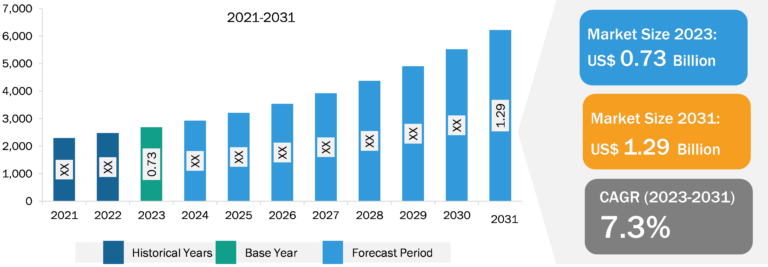
Thin Film and Printed Battery Market
In today’s fast-paced world, consumer electronics have become integral to everyone’s lives. From smartphones to wearable devices, the demand for smaller and more powerful gadgets continues to rise. As consumer electronics continue to shrink in size, traditional battery technologies struggle to keep up with the demand for compact and long-lasting power sources. Thin film and printed batteries, micropower sources, have emerged as a solution to this problem. These thin energy storage devices offer high energy density in a small form factor, making them ideal for powering the ever-shrinking consumer electronics, propelling the thin film and printed battery market growth.
In order to meet the demands of miniaturization, researchers are exploring new materials and designs to enhance energy storage capacity while reducing the size of these batteries. Nanotechnology, for instance, has played a crucial role in developing thin film and printed batteries with higher energy densities and improved cycle life. The applications of thin film and printed batteries extend beyond just smartphones and wearable devices. They are also utilized in medical implants, hearing aids, wireless earphones, and even miniature drones. These energy storage solutions are revolutionizing industries and enabling the development of innovative products that were once unimaginable. Thus, the growing miniaturization of electronic devices has become an important thin film and printed battery market trend.

Germany Holds the Largest Thin Film and Printed Battery Market Size in Europe
According to the thin film and printed battery market forecast, the market in Germany is expected to grow significantly owing to the rise in digitization, 5G implementation, and technological adoption. These high-performance battery systems are essential for the future of industries such as consumer electronics and medical, as they enable sustainable and safe operations. This surge in demand creates significant opportunities for Germany to leverage technological advancements, paving the way for success in the battery market. The convergence of advanced micro battery cells and digital technologies is poised to bring about a revolution across the above industries. This presents Germany with a significant opportunity to establish itself as a key player on the global stage in this pivotal field. By leveraging its expertise in battery technology and embracing digital advancements, Germany can capitalize on this transformative shift and drive innovation and growth in the battery industry. In June 2023, Valmet Automotive inaugurated its first battery plant in Germany, signifying a crucial milestone toward achieving ambitious growth objectives. Thus, all the above factors fuel the thin film and printed battery market growth in Germany.
Thin Film and Printed Battery Market Analysis: Segmental Overview
Based on voltage rating, the market is divided into below 1.5 V, 1.5 V-3 V, and above 3 V. The below 1.5 V segment held the largest thin film and printed battery market share in 2022, whereas the above 3 V segment is anticipated to record the highest CAGR during 2022–2030. In terms of chargeability, the market is categorized into rechargeable and single-use. The rechargeable segment held a larger thin film and printed battery market share in 2022 and is anticipated to record a higher CAGR during 2022–2030. In terms of application, the market is categorized into consumer electronics, medical devices, smart packaging, smart cards, wireless sensors, and others. The consumer electronics segment accounted for the largest share in the market in 2022, whereas the smart cards segment is anticipated to register the highest CAGR during 2022–2030.
Thin Film and Printed Battery Market: Competitive Landscape and Key Developments
Molex LLC, Varta AG, Renata SA, Enfucell Flexible Electronics Ltd, STMicroelectronics, Samsung SDI CO LTD, Excellatron Solid State LLC, Ultralife Corporation, Ilika, and Imprint Energy are among the key players profiled in the thin film and printed battery market report. Several other major players were also studied and analyzed in the thin film and printed battery market report to get a holistic view of the market and its ecosystem. The report provides detailed market insights to help major players strategize their growth.
- In September 2023, the Swiss Federal Laboratories for Materials Science and Technology (Empa) based in the canton of Zurich launched a spin-off company called BTRY. The company plans to drive forward the coming generation of battery technology with an innovative thin-film battery. The thin-film solid-state battery developed at the Empa Laboratory for Thin Films and Photovoltaics provides greater safety and quicker charging times, lasts longer, is not sensitive to temperature, is noncombustible, and can be manufactured in a more environmentally friendly way than lithium-ion batteries.
- In April 2023, Ilika, a developer and manufacturer of advanced solid-state battery technology, announced the successful shipment of its first batch of Stereax batteries from its manufacturing facility in the UK to its customer, Blink Energy. The initial shipment consists of single-layer Stereax M50 cells, which have been allocated to Blink Energy, a provider of device-agnostic power and communications platforms for ocular devices. The M50 cells can be used individually. These cells are also the building blocks for Ilika’s M300 batteries, which are made up of six M50 cells connected in parallel. The ultra-thin profile of the M50 cells is particularly advantageous for Blink Energy, which designs products to power and connect smart ocular devices.
- In December 2021, Ultralife Corporation announced that it had acquired Excell Battery Company. The acquisition will further help Ultralife Corporation increase its capabilities in mission-critical applications, such as downhole drilling, OEM industrial and medical devices, automated meter reading, mining, and marine. Based in Canada with US operations, Excell is a key independent designer and manufacturer of high-performance smart battery systems, battery packs, and monitoring systems to customer specifications.






